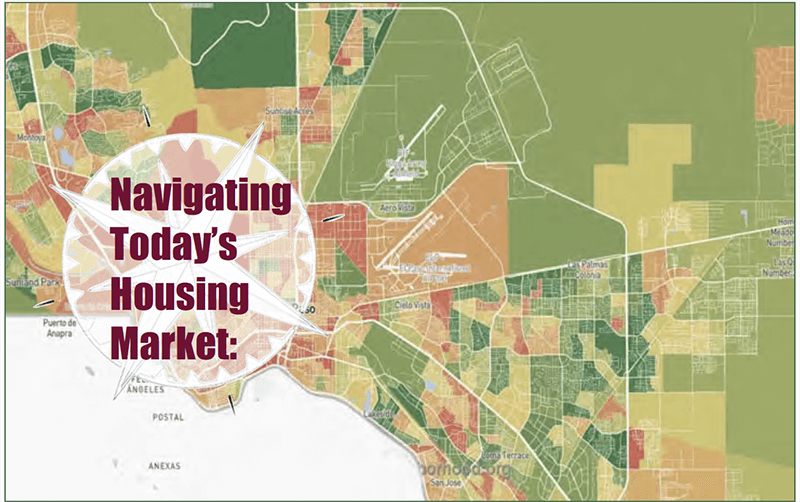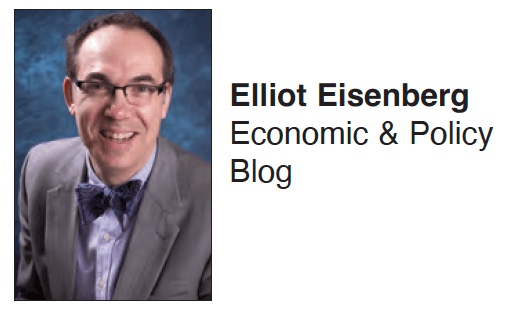Vol 2025, Issue 6 - Builders Outlook
Vol 2025 - Issue 6

What Builders and Industry Partners Need to Know
At the El Paso Association of Builders’ June general membership meeting, Patrick Tuttle—Broker from Coldwell Banker Heritage—delivered an informative presentation on the state of today’s housing market. Drawing from the latest national and local data, Tuttle outlined key trends, challenges, and opportunities that builders and industry professionals need to navigate to meet the demands of a shifting buyer landscape.
By Patrick Tuttle, CRS, CLHMS
Coldwell Banker Heritage
The U.S. housing market—and El Paso in particular—is at a pivotal moment. A combination of shifting buyer demographics, rising costs, and regulatory headwinds is reshaping the real estate landscape. For builders and industry professionals, staying ahead means rethinking what we build, how we price it, and where we focus our efforts.
The Changing Face of the American Homebuyer
According to the 2024 NAR report, first-time homebuyers have dropped to just 24% of the market—a record low. Buyers are also getting older: the average first-time buyer is now 38, while repeat buyers are typically 61. This change reflects economic pressure and delayed life milestones.
Today’s buyers are also more diverse in household makeup. Married couples still lead (62%), but nearly 20% of buyers are single women. Meanwhile, a record 73% of households no longer include children under 18. These shifts point to a growing demand for flexibility in floor plans, affordability, and lifestyle-focused amenities.
El Paso's Market: A Tale of Two Metrics
El Paso has seen an 22% year-over-year increase in home sales, and while inventory has dropped, pricing has softened slightly—down 3% to an average of $316,738. Still, affordability remains a core issue. With a local median income of just under $59,000, more than half of El Paso residents are priced out of new homes, 62% of which are listed above $300,000.
Despite wages rising 12.2% over two years, they haven’t kept pace with the 65% rise in home prices and a 56% increase in borrowing costs. Add to that an 8.4% rise in consumer credit card debt, and it’s clear: affordability is the challenge of the moment.
Policy and Pressure Points
Builders aren’t just battling costs—they’re navigating a volatile regulatory landscape. Interest rates remain high, with the Federal Reserve signaling that relief may not come soon. Meanwhile, Texas homeowners are paying nearly double the national average for insurance—around $6,000 annually—with projections climbing even higher. Twenty-Five percent of homeowners were dropped by their insurers in 2024 alone.
Tariffs and stalled immigration reform are further straining the industry. Labor shortages persist, and the cost of goods remains unpredictable. These realities demand a smarter, more adaptive approach to development.
Building Smarter, Not Bigger
So, what should builders prioritize? Think smaller footprints and smarter layouts. Homes between 1,400 and 1,800 square feet—especially townhomes and multigenerational designs—are emerging as key solutions. Features like energy efficiency, smart home tech, and modest outdoor spaces are now essential, not optional.
The $250,000–$350,000 price range is a sweet spot, aligning closely with local income levels and buyer expectations. And don’t overlook single buyers: 20% of recent purchases were made by single women, while nearly three-quarters of buyers didn’t have young children at home.
Eastward Expansion & Competitive Strategy
East El Paso and Horizon City are seeing growth as families seek more house for their money. Meanwhile, the Westside’s established neighborhoods remain desirable for their convenience and amenities.
Builders should continue offering buyer incentives, agent commissions, and rate buy-downs. Educating clients about rising insurance premiums and affordability realities is more important than ever.
Eyes on the Horizon
The near future may bring more competition for fewer lots, more pricing wars, and increasingly savvy—and demanding—buyers. But that’s not all bad news. Builders who innovate, adapt, and build with today’s buyer in mind are still able to thrive.
The desire for homeownership remains strong. For many, it's not just about shelter—it's about security, stability, and independence. And that’s something worth building for.
For more information or the full presentation email patrick@patricktuttle.com.

INDUSTRY PERSPECTIVE
Slow sales, price resistance, increased competition add to challenges
Serving as President of the Board of Directors for the El Paso Association of Builders has offered me a clear vantage on both local and global forces reshaping our housing landscape. Today, builders and homebuyers are navigating a confluence of affordability constraints, tightening credit, and geopolitical uncertainty that ripple all the way to our region.
In the U.S. housing market, affordability remains a paramount concern. Mortgage rates have hovered near 7 percent in early 2025 after easing briefly in late 2024, upending any hopes for broadly accessible borrowing. Despite some modest moderation, rates are expected to remain in the low‑6s for much of the year—not low enough to draw out locked‑in homeowners at sub‑3 percent rates. That lock‑in effect creates chronic inventory shortages, depressing existing‑home turnover and pushing prices higher.
On the supply side, builders face sharply higher costs: material prices have surged, climbing more than 50 percent since 2020. Add proposed tariffs, labor shortages and labor restrictions, and rising land costs, and new construction is increasingly difficult to pencil out. In May new‑home sales plunged 13.7 percent(their lowest in seven months), despite builders cutting prices and offering generous incentive. National inventory remains low: end‑of‑April data showed just a 4.4‑month supply, well below the 5–6‑month benchmark for a balanced market.
For El Paso and the Borderplex, these forces mean slow-moving sales, growing price resistance among buyers, and increased competition among builders. Incentive programs help, but only so much when borrowing costs remain high and available resale homes are scarce. As your former board president, I saw firsthand how local builders adapted: more flexible pricing tiers, energy‑efficient packages that offer longer‑term savings, and creative financing partnerships to support affordability.
Looking at the global backdrop, recent geopolitical tensions, especially between Iran and Israel (and the U.S.), have injected volatility into global oil markets. Initially, oil prices spiked: Brent and WTI each jumped over 10 percent when Iran’s nuclear sites were struck and threats emerged of a possible shutdown of the Strait of Hormuz . Analysts at JPMorgan warned worse‑case scenarios could push oil up by 75 percent to $120–130 per barrel if the strait were blocked, though base forecasts see prices stabilizing around $60–$67 through 2026.
While oil has since retreated into the mid‑$60s range, the risks remain. Iran’s internal economic crisis, marked by power outages, rampant inflation above 36 percent, and mass strikes disrupting critical supply chains, limits its ability to expand production, and adds uncertainty to long‑term energy supply projections .
For real estate markets, oil and gas shocks translate into inflation pressure, heating, transport, materials, and commuting costs all carry through to both builders and consumers. That, in turn, keeps central banks wary and mortgage rates elevated, reinforcing housing affordability challenges.
In summary, the U.S. housing market remains under strain: limited inventory, elevated mortgage rates, high construction costs, and unpredictable demand. These pressures are compounded by energy price volatility rooted in international conflict. As a former board president, I'm convinced that builders must remain nimble, embracing innovation, affordability measures, and close attention to global headwinds to keep markets moving and homes becoming more accessible.
Sources:
Bussinessinder.com, Marketwatch.com, Apnews.com, Bankrate.com
 |
Executive Message • RAY ADAUTO

How builders fare in legislative session may change in special session
The issues presented this session of the Texas Legislature will fill volumes.
Clearly, as I have said, this session was more defense than offense. What does that mean? Each session the association goes in hoping to pass priority bills, those things that over the two years gone by, we can ask for something to be included or modified to make it better. A law or ruling has the life span of whatever the State Senators or Legislators allow it. Sometimes it’s the courts that determine the lifespan, and also the need for new legislation. This year we asked for priority bills to be worked through the process, but in reality, we had to play defense more than usual. You may be asking why? The limited number of days the session is allowed every two years gets crowded with all kinds of asks, and many times a bill passed in the previous session isn’t liked by everyone, especially if someone is affected negatively. Since some surprises that bills were passed and the Governor vetoed will undoubtedly cause a special session to take place. Early indicators suggest that the special session will commence in August. We’ll keep you informed via email.
 Finally I want to take this time to say goodbye to my friend Ira Batt, the Battman as he proudly proclaimed. Ira was a good soul, a friend to many and a loving husband to Irene. He was a realtor that served his customers so well, his friends always a special kind word, and a giver to his community. Ira had been lovingly taking care of Irene, and I’m sure he longed for her to get better. Like my dad I think Ira just felt that he needed to go talk to Saint Peter and ask him to give Irene help whatever that would be. I will miss this man. I know we are Blessed to have known him and Irene. God grant Ira rest. See you on the other side, my friend.
Finally I want to take this time to say goodbye to my friend Ira Batt, the Battman as he proudly proclaimed. Ira was a good soul, a friend to many and a loving husband to Irene. He was a realtor that served his customers so well, his friends always a special kind word, and a giver to his community. Ira had been lovingly taking care of Irene, and I’m sure he longed for her to get better. Like my dad I think Ira just felt that he needed to go talk to Saint Peter and ask him to give Irene help whatever that would be. I will miss this man. I know we are Blessed to have known him and Irene. God grant Ira rest. See you on the other side, my friend.
 |
Western Governors Association Unveils Housing Plan, Includes NAHB Priorities
During its June 22-24 meeting in Santa Fe, New Mexico, the Western Governors Association (WGA) unveiled a new report focused on expanding housing to western states that includes several initiatives championed by NAHB to address the nation’s housing affordability crisis.
NAHB worked closely with the WGA in drafting the report, Building Resilient and New Affordable Developments in the West, and NAHB Chairman Buddy Hughes participated in a panel that highlighted the key findings and recommendations from the report.
Hughes encouraged the governors to keep the “5 Ls” in mind when working on housing issues:
• Labor,
• Land,
• Lumber and materials,
• Lending, and
• Laws and regulations.
The lack of skilled labor, local land use policies that restrict home and apartment construction, lumber price volatility and elevated material prices, high lending costs for builders, and high regulatory burdens are the main drivers of low housing supply and high home prices, he noted.
The report contains a number of policy objectives recommended by NAHB that seek to ease home building costs and increase the supply of housing.
Notably, it calls on the U.S. Department of Housing and Urban Development (HUD) and U.S. Department of Agriculture (USDA) to carefully consider how new standards, codes and requirements will affect the cost of housing financed by the agencies. Specifically, the report referenced that HUD and USDA have finalized a rule to adopt the 2021 International Energy Conservation Code as the new minimum energy standard for the new construction of housing financed by the agencies. The administration has since announced a six-month delay in enforcing this rule.
Hughes made mention of how a home needs to be built “to the energy code that makes climate and market sense” and not to a higher standard just because a new code is published.
Hughes noted this rule could add as much as $31,000 to the price of a new home and said that NAHB is working on the legal and legislative front to prevent this standard from being imposed because it would drive up housing costs and hinder housing construction at a time when the nation needs to increase the housing supply.
On the federal level, the report also recommended that Congress should:
• Strengthen the Low-Income Housing Tax Credit;
• Support the expansion of education and skills training opportunities for the skilled construction workforce, including apprenticeships and career and technical education;
• Allow exemptions to Davis-Bacon if prevailing wage rates are less than the minimum wage in a jurisdiction;
• Ensure adequate appropriations for housing block grants to state and local governments; and
• Examine potential solutions to growing insurance challenges in collaboration with states and other key partners.
Recommendations to lower housing costs and boost production at the state and local level include:
• Modernize land use regulations;
• Expedite permit plan and review processes;
• Reform zoning laws;
• Remove rules that discourage density and residential development;
• Implement statewide programs focused on development and preservation of housing, such as state low-income housing tax credits and state-specific affordable housing funds.
NAHB supports these initiatives and is a proud contributor to this report, along with a number of western HBAs who also contributed ideas and worked to put this housing blueprint together.
 |
Higher Rates, Affordability Conditions Dampen New Home Sales
Elevated interest rates and economic uncertainty sent more home buyers to the sidelines in May as housing affordability conditions remain challenging.
 Sales of newly built single-family homes declined 13.7% in May, falling back to a seasonally adjusted annual rate of 623,000, according to newly released data from the U.S. Department of Housing and Urban Development and the U.S. Census Bureau. This was the slowest pace since October of last year, as mortgage rates averaged 6.83% in May. Sales were particularly slow in the South, with the pace of sales down 21% in May.
Sales of newly built single-family homes declined 13.7% in May, falling back to a seasonally adjusted annual rate of 623,000, according to newly released data from the U.S. Department of Housing and Urban Development and the U.S. Census Bureau. This was the slowest pace since October of last year, as mortgage rates averaged 6.83% in May. Sales were particularly slow in the South, with the pace of sales down 21% in May.
“Housing affordability conditions have pushed more buyers to the sidelines, as reflected in our latest builder survey,” said Buddy Hughes, chairman of the National Association of Home Builders (NAHB) and a home builder and developer from Lexington, N.C. “Despite the use of builder sales incentives, including 37% of home builders reporting cutting prices in the recent NAHB survey, the housing market has slowed.”
“On a year-to-date basis, new home sales are 3.2% lower thus far in 2025,” said NAHB Chief Economist Robert Dietz. “As a result of slowing home sales conditions, inventory continues to rise, marking an elevated 9.8 months’ supply in May. Builders will be pulling back on construction in the months ahead due to this level of inventory.”
As estimated by NAHB, total months’ supply, a combination of current new and resale single-family inventory, now stands at 5.2. This is the highest sales-adjusted inventory level since 2015 and Dietz noted this will place downward pressure on housing construction starts in the months ahead.
A new home sale occurs when a sales contract is signed, or a deposit is accepted. The home can be in any stage of construction: not yet started, under construction or completed. In addition to adjusting for seasonal effects, the May reading of 623,000 units is the number of homes that would sell if this pace continued for the next 12 months.
New single-family home inventory continued to rise with 507,000 residences marketed for sale as of May. This is 1.4% higher than the previous month, and 8.1% higher than a year ago. At the current sales pace, the months’ supply for new homes stands at 9.8 compared to 8.5 a year ago.
The median new home sale price in May was $426,600, compared to $414,300 a year ago. This measure reflects the fact that higher income borrowers face fewer budget constraints than lower income prospective home buyers. New home sales priced below $500,000 were down 15% in May of 2025 compared to the May 2024.
Regionally, on a year-to-date basis, new home sales are down 20.7% in the Northeast, 11.9% in the Midwest and 1.8% in the South. Sales are up 2.1% in the West.
Builder Sentiment at Third Lowest Reading Since 2012
In a further sign of declining builder sentiment, the use of price incentives increased sharply in June as the housing market continues to soften.
Builder confidence in the market for newly built single-family homes was 32 in June, down two points from May, according to the National Association of Home Builders (NAHB)/Wells Fargo Housing Market Index (HMI) released today. The index has only posted a lower reading twice since 2012 – in December 2022 when it hit 31 and in April 2020 at the start of the pandemic when it plunged more than 40 points to 30.
“Buyers are increasingly moving to the sidelines due to elevated mortgage rates and tariff and economic uncertainty,” said NAHB Chairman Buddy Hughes, a home builder and developer from Lexington, N.C. “To help address affordability concerns and bring hesitant buyers off the fence, a growing number of builders are moving to cut prices.”
Indeed, the latest HMI survey also revealed that 37% of builders reported cutting prices in June, the highest percentage since NAHB began tracking this figure on a monthly basis in 2022. This compares with 34% of builders who reported cutting prices in May and 29% in April. Meanwhile, the average price reduction was 5% in June, the same as it’s been every month since last November. The use of sales incentives was 62% in June, up one percentage point from May.
“Rising inventory levels and prospective home buyers who are on hold waiting for affordability conditions to improve are resulting in weakening price growth in most markets and generating price declines for resales in a growing number of markets,” said NAHB Chief Economist Robert Dietz. “Given current market conditions, NAHB is forecasting a decline in single-family starts for 2025.”
Derived from a monthly survey that NAHB has been conducting for more than 35 years, the NAHB/Wells Fargo HMI gauges builder perceptions of current single-family home sales and sales expectations for the next six months as “good,” “fair” or “poor.” The survey also asks builders to rate traffic of prospective buyers as “high to very high,” “average” or “low to very low.” Scores for each component are then used to calculate a seasonally adjusted index where any number over 50 indicates that more builders view conditions as good than poor.
All three of the major HMI indices posted losses in June. The HMI index gauging current sales conditions fell two points in June to a level of 35, the component measuring sales expectations in the next six months dropped two points lower to 40 while the gauge charting traffic of prospective buyers posted a two-point decline to 21, the lowest reading since November 2023.
Looking at the three-month moving averages for regional HMI scores, the Northeast fell one point to 43, the Midwest moved one point higher to 41, the South dropped three points to 33 and the West declined four points to 28.
ECONOMIC OUTLOOK
Repetitive Revisions
On 3/7/25, February net employment was initially reported as 151,000, but after multiple revisions the real number is 102,000. On 4/4/25, March employment was reported as 228,000, but now we know the number is 120,000. On 5/2/25, April employment was said to be 177,000, but it’s already been revised down to 147,000, and another revision is due next month. On 6/6/25, May employment was pegged at 139,000, yeah right.
Fed Focus
To the surprise of nobody, the Fed kept rates unchanged at today’s meeting. Powell deftly suggested that the Fed could adjust to what comes next, while simultaneously admitting it has no idea what to expect. As for the dot plots suggesting two 25bps rate cuts, ignore them. In this environment of extreme policy uncertainty, they’re meaningless. The Fed clearly feels the labor market hasn’t sufficiently buckled to warrant rate relief.
Horrible Hate
In 2023, there were 291 hate crimes/million Jews, almost three times higher than the next most victimized group, the LGBTQ community at 111. In third, anti-Muslim hate crimes are at 79, then comes anti-Arab at 70, and rounding out the hated top five, anti-Black hate crimes at 64. Anti-Asian hate crimes are at 17, anti-Native-American follow at 15, then anti-Hispanic at 13. No other group exceeds nine. Halt the Hate!
Weekly Weakness
Unemployment claims came in at 248K for the week of 6/7, tied for the highest level in eight months. The four-week moving average of 240K is at the highest level since 8/23. As for continuing claims, they’re also rising. For the week of 5/31 they’re at 1.956 million, a big jump from 1.902 million a week earlier, and are at their highest level since 11/13/21. Back then, rates near zero!
Tariff Totals
US imports of goods total $3.7 trillion/year, 12.3% of GDP. Assuming a 10% across-the-board tariff and no behavioral changes, somewhat unrealistic, this would lead to $370 billion/year in tariffs. Assuming they are all passed on to consumers through higher prices, this would result in a one-time inflation hike of 1.2 percentage points, driving inflation from 2.5% to a temporary peak of 3.7% then down again. Not great, but hardly catastrophic.
Stock Superstition
The Friday File: Since 1928, the stock market, on average, has returned a superbly spooky 0.09% on Fridays the 13th. On all other Fridays the return is still a ghostly strong 0.05%. That’s because on all trading days the return is 0.03%, one-third the Friday the 13th average, 60% of a regular Friday return. It’s time to start treating Friday the 13th with the financial reverence and respect it deserves!
CBO Concerns
The CBO recently forecast that if added interest is included, the One Big Beautiful Bill Act passed by the House will, if it becomes law, increase the national debt by $3 trillion above baseline through 2034. Many have criticized the CBO for the poor quality of earlier estimates. The criticism is valid. Looking at CBO projected US deficits vs. actual deficits between 1999-2024, CBO projections have chronically underestimated actual deficits.
Poor Performance
CY2025 looks to grow meekly for many reasons. First, fiscal policy is contractionary primarily due to required repayment of student loans, but also the likely removal of green energy tax credits. Second, tariffs are increasing uncertainty which reduces capex. Third, declining immigration will reduce employment and thus GDP growth. Lastly, monetary policy is also contractionary with rates too high. Collectively, these impacts probably slice one percentage point off GDP growth.
Elliot Eisenberg, Ph.D. is an internationally acclaimed economist and public speaker specializing in making economics fun, relevant and educational. Dr. Eisenberg earned a B.A. in economics with first class honors from McGill University in Montreal, as well as a Master and Ph.D. in public administration from Syracuse University. Eisenberg is the Chief Economist for GraphsandLaughs, LLC, a Miami-based economic consultancy that serves a variety of clients across the United States. He writes a syndicated column and authors a daily 70-word commentary on the economy that is available at www.econ70.com.
An Appreciation Of FedEx Founder, Frederick W. Smith
By Jens Flottau June 2025
On that first day, when FedEx launched cargo flights in 1973, the small airline transported 186 packages to 24 cities. On an average day in 2025, the airline flies around 17 million shipments.
In between those dates are some lows—the small airline almost ran out of money more than once in the early years—and many highs. Because of the initial crises, two half-sisters of Smith once sued him in the 1970s over concerns that the significant family inheritance created by his father would vanish in his attempts to establish this new airline with its strange business model. But over time, it was exactly that model that not only made Smith himself a multibillionaire but transformed the airline industry: it has since been called hub and spoke.
Smith, son of a wealthy businessman owning a large bus company, studied in Yale and worked as a charter pilot. At Yale, he laid out his later vision of what would become FedEx as early as 1965. He served as a Marine pilot in the Vietnam War. Years later, he turned his Yale theory into practice and not only launched a cargo airline focused on business-to-business shipments of small parcels but invented the idea of the hub.
Smith bought a fleet of 14 Dassault Falcon 20s for the launch of FedEx. The hub, built in Memphis because the weather was generally good and the airport had space for the new operator, connected multiple destinations with a one-stop connection, enabling the small airline to offer its services in many more markets.
The same principle has later been adopted by passenger airlines. KLM Royal Dutch was an early adopter, enabling it to grow Amsterdam way beyond the demand of the local market. Over time, most large international airlines followed the hub-and-spoke strategy. The big three in the U.S. operate multiple hubs, the big three in the Middle East have taken the concept further by offering long-haul to long-haul connections. And whenever airlines want to grasp the opportunity in an emerging market, they are building hubs. Even LCCs, which launched on the premise of trying the exact opposite, have long recognized the value of at least some connecting flows supporting their networks when local demand is not strong enough.
Initially limited to a small domestic network, FedEx expanded to become a global logistics company, though Memphis remained its core. According to the Aviation Week Network Fleet Discovery database, FedEx currently has a fleet of 371 mostly widebody aircraft. FedEx employs more than 500,000 people and serves around 220 countries and territories.
Along with a few other examples, such as Dubai, FedEx’s Memphis operation is busiest during the night. Then, the apron is full of widebodies that are unloaded and reloaded after their cargo has been processed through and redistributed in its huge ground facilities. To be able to better compete, Smith bought a ground distribution company, FedEx Ground, which uses licensed truck companies and their drivers to deliver goods to their destinations.
The rise of e-commerce became an opportunity and challenge at the same time. Demand for exactly the kind of cargo FedEx specialized in rose dramatically, yet its business model was designed for the higher yield business to business segment. In 2019, FedEx and Amazon terminated a deal to transport packages as they could not agree on pricing.
Over the years, Smith has also become deeply involved in American politics. He had studied together with former U.S. President George W. Bush, who called him “one of the finest Americans of our generation.” He was considered for the U.S. Secretary of Defense position under Bush.
Smith has been a major supporter of free trade, in contrast to the push for tariffs and barriers pursued by the current U.S. administration. Yet, the New York Times reported that FedEx’s corporate tax bill went from $1.5 billion to zero as part of the tax cuts introduced by President Donald Trump, a welcome result of its own lobbying campaign.
Smith remained FedEx CEO until 2022 and then took the role of executive chairman. “Frederick W. Smith pioneered express delivery and connected the world, shaping global commerce as we know it,” FedEx President and CEO Raj Subramaniam wrote. “His legacy of innovation, leadership, and philanthropy will continue to inspire future generations.”
Fred Smith died June 21 in Memphis at age 80.
Posted on Aviation Week Network


